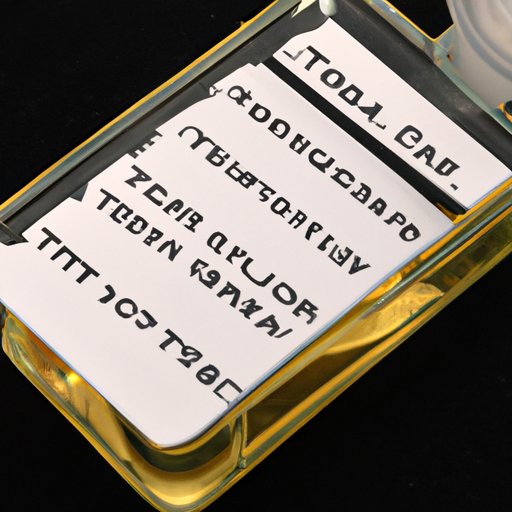Introduction
When it comes to packing for air travel, it’s important to know the strict liquid restrictions enforced by the Transportation Security Administration (TSA). This guide will break down the limitations on liquid items on a plane and offer tips on how to maximize your carry-on while also being TSA-compliant.
The Ultimate Guide to TSA’s Liquid Restrictions on Airplanes
First, let’s review the basics of TSA’s rules and regulations. In order to ensure the safety of all passengers, the TSA has implemented a 3-1-1 liquids rule for carry-on bags. This means that all liquids, aerosols, and gels must be in three-ounce or smaller containers, placed in a one-quart clear, plastic, zip-top bag, and each passenger is allowed only one of these bags.
There is no limit to the amount of liquid items you can bring in your checked baggage, but it’s important to remember that these items must still be TSA-compliant. It’s also important to note that TSA’s liquid restrictions apply to all flights departing from the United States, regardless of the destination.
While most liquids are restricted, there are some exceptions to the rule. These include medication, baby formula, and breast milk, which are allowed in quantities exceeding three ounces as long as they are presented to the TSA for inspection. Additionally, duty-free liquids purchased in a secure airport area can also be allowed, but only in a tamper-evident bag.
Flying with Liquids: Know Your Limits on the Amount of Ounces Allowed
As previously mentioned, TSA’s 3-1-1 liquids rule limits the amount of liquid per container to three ounces or less. It’s important to properly measure any liquids you plan on bringing to ensure they comply with this rule, as any container that is larger than three ounces will not be permitted through security.
To measure liquid ounces, you can use a kitchen scale or a measuring cup. It’s important to note that while some liquid items may come in a container that is less than three ounces, if the container can hold more than three ounces of liquid, it still will not be permitted through security. Similarly, any items that appear to be altered or tampered with may be subject to additional inspection or confiscation.
Maximizing Your Carry-On: Understanding the Rule of TSA’s Liquid Quantity
With the limited amount of space in a carry-on bag, it’s important to make the most of the one quart-sized clear plastic bag allowed by TSA’s liquid restrictions. To do this, it’s important to prioritize what liquids are absolutely necessary to bring on board, and which ones can be left behind.
When packing liquids, it’s also important to keep in mind that certain items don’t count towards your liquid limit. These items include solid items such as lipstick, lip balm, and stick deodorant, as well as items purchased after the security checkpoint.
Flying Smart: Tips for Avoiding Liquid Restrictions on Airplanes
In order to reduce the amount of liquid items you need to bring, consider alternative items that accomplish the same task. For example, instead of bringing a full bottle of shampoo or conditioner, invest in travel-sized bars of shampoo and conditioner, which can take up less space in your carry-on and won’t be subject to TSA’s liquid restrictions.
Another way to avoid liquid restrictions is to bring items that have dual purposes, such as a moisturizer that also has SPF, or a tinted lip balm that can be used as blush.
The Dos and Don’ts of Packing Liquid Items for Air Travel
When it comes to packing liquid items, it’s important to follow TSA’s guidelines to ensure easy travel and avoid any delays or confiscations. Do pack items in a clear, plastic, resealable bag and make sure they comply with TSA’s 3-1-1 rule.
Don’t bring any prohibited items, such as containers of more than three ounces, non-medically necessary aerosols or gels, or any items that appear to be tampered with. Additionally, don’t forget to pack any liquids you may need during the flight in your carry-on bag, as checked bags may be subject to additional screening and delays.
Navigating TSA Restrictions: How Many Ounces Are Allowed on a Plane?
Common questions about TSA’s liquid restrictions include how many ounces are allowed on a plane. The answer is that each container must be three ounces or less, and all containers must fit into a one quart-sized clear plastic, resealable bag. Each passenger is allowed only one of these bags in their carry-on bag.
It’s important to note that while the 3-1-1 rule is the standard across all airlines, individual airlines may have additional restrictions or guidelines in place. Be sure to check with your airline before packing to avoid any issues at security.
Avoiding Liquid Hassles: Everything You Need to Know About Airline Carry-On Restrictions
Aside from TSA’s liquid restrictions, it’s important to note that individual airlines may have their own guidelines and restrictions in place. For example, some airlines may have restrictions on the size and weight of carry-on baggage, or may charge additional fees for carry-on items.
Additionally, some airlines may have their own restrictions on the types of liquids that are allowed on board, even if they comply with TSA’s rules. Be sure to check with your airline for any additional guidelines or restrictions before packing.
Conclusion
In conclusion, knowing and following TSA’s liquid restrictions is essential in order to make your air travel experience as seamless and hassle-free as possible. By understanding the 3-1-1 rule, properly measuring liquid ounces, and being aware of airline-specific guidelines, you can ensure easy travel and avoid any potential conflicts during security screenings.
Remember to prioritize what liquid items you absolutely need in your carry-on, how to maximize the space in your one quart-sized plastic bag, and alternative items you can bring to reduce the amount of liquid items you need to pack. With these tips and tricks, you can travel smart and efficiently with all the necessary liquids in tow.
